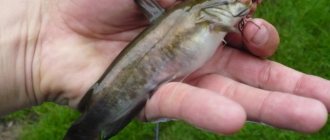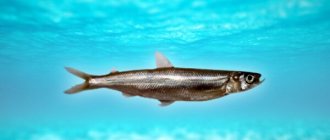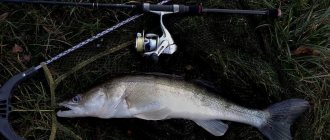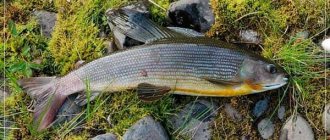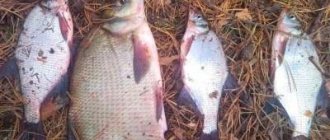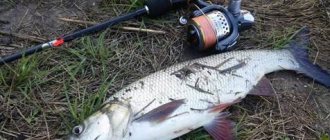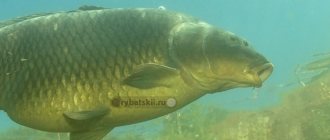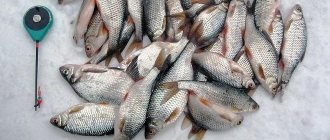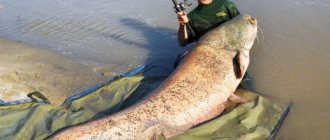When to fish?
You can catch smelt both in summer and winter. Fishing is carried out using a float rod with small spoons and jigs.
- The active feeding of smelt in the fall begins in September and continues until freeze-up. At this time, smelt fishing promises to be successful.
- At this time, smelt fishing is carried out by fishing on rivers, as well as with a float rod if the reservoir is closed: during this period the fish feeds on bloodworms around the clock.
- In late autumn, when ice begins to freeze, the fish go into deep water, and fishing can only be done at depth. Fishing there occurs right up to the beginning of spring, when the ice melts. Fish rarely move into shallow water. You can catch it at this time from a boat, and it is better to use a winter fishing rod. To do this, you will need special jigs for smelt or bait in the form of bloodworms.
- In winter, after the ice has settled, smelt are caught using winter float gear. The best bait for this is burdock moth larva, bloodworms. Winter fishing is most effective with a jig during the freeze-up period, as well as on the last ice. At this time, the fish are more active at shallow depths, and they bite well.
Equipment
Smelt fishing takes place in the northern seas, and the largest specimens of this fish weigh only 400 grams. Tackle for catching smelt is very diverse. How to catch smelt, what equipment should be used to catch it? Let's start with the fishing line.
To catch smelt, it is appropriate to use thin line with a diameter of 0.2 to 0.25 millimeters: it is practically invisible under water, so the bite will be better.
But such a line gets tangled very easily: to prevent this from happening, fishermen use a little trick: they tie a thin line to a thick line, so that only the thin line will be under water.
But the smallmouth smelt cannot gnaw through the fishing line because it has weak teeth. Fishing with such a fishing line can be done at a depth of up to 30 meters.
Equipment is not only fishing line, but also sinkers, hooks, baits and the actual equipment itself. If the fishing is river fishing, then it is appropriate to use heavy weights weighing 50-60 grams so that the gear does not drift away with the current.
If river fishing takes place in places with low currents, then you can choose lighter weights. And in a stagnant body of water, sinkers should weigh 5-10 grams.
It is very convenient to hang the sinker from the tackle on a carabiner so that you can change its height: this is important if you are fishing in rivers, where the current can be different.
- The bait can be anything: it can be artificial jigs, spinners, and natural baits of animal origin, as in the video. Hooks for small fish should be chosen in sizes No. 4-7. The smaller the specimens, the smaller the hooks should be. Take large hooks with you only when fishing will be carried out only for large individuals.
- The bait should be small, planted close to the jig. A small piece of fresh fish is used as it. Fishing is very effective with light-accumulating multi-colored jigs. Fishing will be even better if the jigs are placed in several layers, and the fishing rod is used in conjunction with a spoon.
Source: https://marine-fish.ru/ohota-rybalka-vchora-o-20-00-19.html
Where do you catch smelt in winter?
This small fish usually gathers in impressive schools - one such cluster can reach a ton in mass. Moreover, there are several such schools in one water area of the reservoir. Therefore, the density of accumulation of this fish in certain areas is quite high.
Smelt leads a gregarious lifestyle
To understand the location of smelt schools, it is enough to look at a body of water covered with ice. Where there are the most fishermen, there is a good bite.
Mainly localized at the border of the confluence of small rivers with large ones (bed). Firstly, here the water is more saturated with oxygen, and secondly, the fish are preparing to quickly leave for spawning up the tributaries into small rivers.
Experienced fishermen advise looking for smelt in the following places:
- river tributaries;
- areas with a flat bottom;
- at shallow depths.
Usually they are caught at a depth of no more than 7-8 meters. True, there are exceptions - the fish goes up to 20 meters down (depending on weather conditions). Typically, the fish bites at a distance of 1 meter from the bottom. It is at this level that you need to play with the bait, periodically plunging it all the way to the ground.
Question about gear for winter fishing for smelt and navaga
Please tell me, do you use spinners and the technique described below when catching smelt, navaga or other fish in winter in your region?
In the Primorsky Territory, when fishing for smelt, catfish and navaga in winter, they have long used lightweight spinners that are not burdened by the presence of lead. A lightweight spinner with an elongated teardrop shape, due to its peculiar curved shape at the moment of free fall, its play most closely resembles the natural movement of a small fish.
- These spoons are made of brass, copper, cupronickel, etc. Spoons made using this method are also good because the size of the spoon has little effect on the size of the fish that takes it. Very often, a lure 100 mm long can be used to catch fish much smaller in size than the lure itself.
- At the same time, large fish take the lure at 20-30 mm.
- Of course, such a lure also requires special fishing rod equipment. The main difference from conventional equipment is the shape and location of the sinker.
- The sinker is cast in the shape of a spindle with a piece of wire 1 mm thick passed inside it. After casting the sinker, the wire is cut so that 2 cm remains from both ends of the sinker.
- Then two 2 cm sections of cambric are selected, equal in thickness to the wire mounted in the sinker.
I don’t specifically focus on the size and therefore the weight of the sinker, because... these parameters depend on the fishing depth, the presence and strength of the current. Therefore, fishermen, as a rule, carry with them, along with a set of spinners of different sizes (from 20 mm to 100 mm) and a set of sinkers of different weights.
Coastal fishermen use fishing rods made of dense foam plastic with a reel; a strip of bamboo or fiberglass is suitable as a fishing rod. A rubber ring from an old hose of the appropriate diameter is placed on the tip of the fishing rod to secure the fishing line. 15 meters of fishing line 0.3 or thicker are wound on the reel, because a thick fishing line gets tangled less, and if you still can’t avoid a beard, it’s much easier to untangle it. Pass the free end of the fishing line through the rubber ring and put the prepared cambrics on it (for attaching the sinker). A loop is made at the end of the fishing line. The selected sinker is inserted into the cambrics.
The spoon is attached to the main line using a leash. The leash is made 50-70 cm long from a fishing line with a diameter of 0.17 cm or the diameter that suits you when catching a particular fish. A loop is also made at the end of the leash.
The leash with the lure is attached to the main line using the “loop-to-loop” method, which allows you to quickly and easily change the leash with another lure.
- Such equipment for a winter fishing rod also requires a special way to set the fishing depth. Since the spoon itself is much lighter than the sinker, determining the moment it touches the ground is not an easy task. There are two options to solve this.
- You notice how many revolutions the leash takes on the reel and, after the sinker has touched the bottom, you rewind the number of revolutions of the leash you noticed back onto the reel. For the second option, it is necessary to make a “diver”.
- A “diver” is an ordinary sinker weighing 30-50 grams covered with fabric. So, you place the “diver” on the spoon and first remove the rubber ring from the tip of the fishing rod, which presses the main fishing line to it.
- Lower the tip of the rod to the hole and unwind the line from the reel until the “diver” touches the bottom. Having fixed the main line on the fishing rod with a rubber ring, you select the tackle and remove the “diver”.
- Thus, the distance of the tip of the fishing rod from the hole will be equal to the distance of your spoon from the bottom, and you can easily and “visually” fish any layer of the water column, moving away from the hole or, on the contrary, sitting down to it.
- The fishing technique itself is quite simple. A small short swing of the fishing rod and your spoon is torn off the ground and soars into the water column. A short pause, allowing the spoon to glide back to the bottom and swing and hook again.
The game of the spinners is tested at home in the bathroom. A correctly made spoon, after lifting, progressively floats “on its back” to the side. The fish always grabs the spoon as it falls.
In order not to unnecessarily freeze their hands when removing gloves, our fishermen use hooks on spinners without barbs, and to prevent the fish from coming off after hooking, it is reeled in with quick swings that do not weaken the line, wrapping the line around the hands.
After removing the fish, it is thrown onto the ice and the spoon unhooks itself. All that remains is to lower the sinker into the hole and release the wound line from your hands.
Very advanced spinners can fish with EIGHT different spinners at the same time (four on each rod) and accurately reel in the line that caught the fish.
Source: https://kopilka-rybaka.ru/blog/43161963266
Winter fishing for smelt - behavioral characteristics and choice of gear
Smelt is definitely not a fish that can boast of impressive size. However, in the places where it lives, its fishing is very popular. This is partly due to the taste of the dishes prepared from this small fish, and partly because you won’t be bored while fishing.
If it is possible to discover the site of a school of smelt (and this is a schooling fish, and the number of such schools can be impressive), then the catch will be measured in kilograms. Smelt is caught in winter using different types of gear.
Both winter fishing rods with jigs, which are familiar for winter fishing for other types of fish, are used, as well as gear used primarily for smelt, for example, the so-called “flyers”. Fishing can be either daytime or nighttime - the activity of this fish is quite high at any time of the day. Interestingly, smelt are caught mainly in winter.
Perhaps in summer or autumn it is not so difficult to hunt for more worthy trophies, and perhaps a certain change in the taste of fish meat, which occurs in the warm season, and is probably associated with a change in diet, plays a role.
Peculiarities of smelt behavior in winter
The behavior of this fish is somewhat different from the behavior of other species. The most unusual thing for many anglers is the favorite stopping places for smelt.
- It prefers areas of a reservoir with a flat bottom topography, while most fish choose various anomalies on the bottom - snags, holes, stones, etc. (although many anglers claim that this fish is also found near bottom unevenness, and catches over flat areas are associated with pre-spawning migrations).
- In winter, smelt gather in large schools, and detecting them is the main task of the fisherman, because if a large concentration is identified, an impressive catch is almost guaranteed. Important! The most successful time for catching smelt is considered to be February and March, although fishing can be successful throughout the winter season.
- You should look for smelt near the points where large and small tributaries flow into the reservoir. At the end of winter, this is due not only to the fact that in such places there is a higher oxygen content in the water, as well as more food, but also to the upcoming spawning, during which the fish will rise up the tributaries to lay eggs.
Once smelt begins to be actively caught with winter gear, it is not difficult to discover promising fishing spots. As a rule, dozens and, in some reservoirs, hundreds of fishermen gather above the points where schools of this fish stand. At the same time, the number of schools is such that none of the fishermen is left without a catch.
Smelt bite almost around the clock, but evening and morning bursts of activity are still observed. It is important to take into account that this fish is not at all afraid of light, and even on the contrary, holes illuminated by a flashlight, as a rule, turn out to be more catchy.
Fishing with a jig
Catching smelt in winter, like many other fish, is possible using jigs. A wide variety of fishing rods are suitable for such fishing, from homemade options to winter “balalaikas”, beloved by athletes. If necessary, it is easy to make a winter fishing rod yourself.
Foam plastic is a favorite material among DIY enthusiasts - such fishing rods are both light and warm, which is especially important for winter fishing. At the request of the fisherman, the fishing rod can be equipped with a mount for a reel, or you can limit yourself to a reel cut directly on the fishing rod for a supply of fishing line.
To indicate a bite, as well as to ensure proper play of the jig, an appropriate nod is selected.
Catching smelt in winter involves using thin monofilaments. Diameters in the range of 0.15 to 0.2 millimeters are popular, but many experienced fishermen recommend using thinner options - from 0.08 to 0.12 millimeters.
It is believed that if the fish are inactive on the day of fishing, a thinner line in combination with the smallest possible jig can increase the number of bites.
Important! If fish activity is poor, you can try to revive the bite using glow-in-the-dark phosphor jigs.
Smelt fishing in winter is carried out using small jigs with a diameter of no more than 4-6 millimeters. Using larger options often results in fewer bites. It is advisable to have jigs of different colors in your arsenal - silver, gold, copper, since it is difficult to predict which one will work better on the day of fishing.
Use of baits and groundbaits
- Bait is not always used to catch this fish. Often, if the angler has found a school location, this is not necessary. However, sometimes complementary foods are still used. Since smelt is a predator, the appropriate ingredients are used - pieces of fish of different types, shrimp, bloodworms, chopped dung worm.
- These components are either thrown in small quantities directly into the hole, or they are hidden in balls of clay or soil from the banks of the reservoir. The bait used is usually approximately the same as groundbait.
- Good results come from using pieces of fish of various types, including smelt itself, shrimp, crab sticks, bloodworms, maggots, and red dung worms.
"Whatnot" and the tyrant
“Whatnot” is another tackle for catching smelt in winter, popular with many fans of such fishing. It differs from the usual tackle in the number of jigs - they usually knit 3-4 pieces (it is considered that it is not advisable to knit more, since such tackle will only get more tangled). They are attached at a distance of about a meter and a half from each other.
- At the same time, it is important to make the leads of the upper jigs short - this will make it easier to pull the tackle out of the hole. This type of gear allows you to simultaneously fish almost all depths, and is especially effective when the fish are active. However, there are also situations when out of 4 pieces only one jig works, and the smelt ignores the rest.
- Many fishermen also prefer to knit different jigs on the “whatnot”, differing in color, size, shape, and the presence or absence of light-accumulating paint. Tyrant tackle is well known to sea fishing enthusiasts. It is a piece of fishing line with a sinker at the end, to which sometimes a very significant number of hooks are attached.
The attractiveness of the latter is increased by putting pieces of multi-colored latex on hooks, or by tying woolen threads.
Important! In the case of the tyrant, and with other winter gear, it’s good to have several spare ones - this way there will be no need to tie the equipment in the cold.
Fishing with "flyers"
Fishing with “flyers” is also very popular, and with proper skill it can be very catchy. However, it should be borne in mind that this is a rather peculiar tackle. The rods used are very long for winter fishing - from 50 to 90 centimeters.
Miniature spinners are used as bait, the main distinguishing feature of which is the absence of barbs on the hooks.
Factory-produced spinners for catching smelt are often very expensive, so many fishermen make them themselves.
The fishing process looks like this:
- First, the fisherman drills two holes located close to each other.
- The fisherman takes two fishing rods and lowers the lures into the water.
- He empirically determines the depth of fishing, after which he fixes the length of the fishing line, and then plays the spoon on this horizon.
When bitten, the fish is simply pulled out of the hole, and when falling onto the ice, the smelt itself frees itself from the hook, which does not have a barb.
In the case of an intense bite, both when retrieving and pulling out the fish, the fisherman has to wave his arms very intensively, which probably gave the fishing method its name.
Fishing with “swallows” is very popular, since this catchy method allows you not only to quickly catch a lot of smelt, but also without getting your hands wet. However, mastering the placement of spinners, as well as getting used to the pace of fishing, takes time.
Source:
Source: https://catcher.fish/ekspertnyi-tsentr/fishexpert/zimnyaya-ry-balka-na-koryushku-osobennosti-povedeniya-i-vy-bor-snastej/
Fishing technique
The choice of specific equipment largely depends on the weather and the activity of the fisherman. Despite the fact that this fish usually bites well in winter, sometimes it refuses to respond to different baits. Then the fisherman has to use all his experience and skill to adapt to the prey. It is important to notice the bite in time and make a sharp hook.
Make sure that the gear does not get tangled with each other. Therefore, holes should be drilled perpendicular to the direction of water movement in the river.
Fishing with a float
Catching smelt in winter is not difficult; even a beginner can cope with it. If the fish are active, one fishing rod will be enough. First of all, the fisherman looks for a place, then uses an ice ax to make a hole (one or more). Crushed ice is scooped out of them. There is no need to throw in bait, but you can start fishing right away.
The bait is immersed under the ice so that the float submerges slightly. They fix the fishing rod in a snowdrift and wait for a bite. When a fish is hooked, the float will float up. You need to hook right away.
Despite the fact that fishing with a float rod is passive, it is sometimes more effective than active fishing (when using nodding tackle).
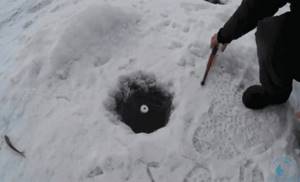
When float fishing, use a jig or a typical hook. In the first scenario, the jig replaces the sinker. In strong currents, when the weight of the bait is not enough, a weight is tied to the lower part of the fishing line. The hook is attached a few centimeters higher.
With this method of fishing, only live bait is suitable. You have to be prepared to change it often, which is not particularly comfortable to do with bare hands in the cold.
Fishing with flywheels
Fishing using a flywheel makes the process more interesting and much more productive. The bait is special short spinners (6-10 mm) with a diameter of about 5 mm. You can use small hooks with weights and additional attributes (feathering). This type of tackle is equipped with hooks without notches, which do not allow the fish to escape. Usually fishermen grind off the teeth or buy initially smooth products.
The fishing rod should be about 1 meter long, preferably telescopic.
This is done in order not to waste time unhooking the caught fish - it flies off on its own when it hits the ice. All movements of the fisherman must be fast and coordinated in order to catch as many smelt as possible.

Smooth hooks (without barb) for a fly rod
The bait used here is the same as when fishing with a tyrant: latex, elastic bands, threads. The fisherman conveniently positions himself between two holes and begins to quickly throw the swings one by one. At the same time, your hands remain dry, since the smelt itself flies off the hook onto the ice when it is removed from the water.
Video review of catching smelt with flywheels:
Fishing with a garland
A garland is a type of gear. It consists of a fishing line with several jigs attached at a distance of 25-50 cm. This device is useful when fishing in reservoirs with little or no current, in deep water areas. Usually these are pits over 5 meters deep.
With the help of a garland it is possible to get fish from different water layers. The jigs are positioned in such a way that it is possible to probe the water column at different levels. After the first catch, it is clear at what depth the school is grouped.
The optimal length of the garland is 2 meters with a maximum of five jigs. If the tackle is too long, the fish will rush from one hole to another, which will cause a lot of trouble for the fisherman.
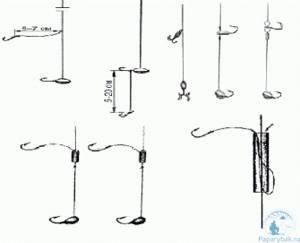
A garland that is short in length can be pulled out freely without winding it up. This makes the fisherman's work easier. After discovering a school, it is better to change the tackle to a simpler one.
Experienced fishermen assemble a garland of jigs of the same type. But for beginners, it is recommended to use different weights and attach them as follows: the heaviest one at the bottom, then in descending order of weight. The top jig should be lighter than all the previous ones. This technique helps you find the bottom faster.
Fishing with artificial bait
Smelt is a predatory fish, which means it can be successfully caught using artificial bait (jigs, spoons). In this case, they use a fishing rod equipped with a springy metal nod. The base line should have a diameter in the range of 0.14-0.20 mm. Sometimes you can use thicker monofilament thread.
Jigs are selected that are small but heavy (for example, made of tungsten) so that they sink faster to the ground. The preferred color is light, with a phosphorescent effect. Among the spinners, choose smaller products - about 2 cm long, golden or steel in color.
The bait is placed on a hook and the tackle is immersed in the water. Fishing can be done with a stationary or movable bait. The technique of the game is simple - raising and lowering the tackle with periodic stops.

Good fishing
A few final secrets:
- when fishing for smelt at river mouths, the holes should be located across the current and in a checkerboard pattern;
- Maggots and krill meat have proven themselves well as bait;
- the holes should be regularly cleared of accumulated layers of snow and small pieces of ice.
Ice fishing for smelt: tackle and bait
Smelt is a very interesting fish. This is the only fish that smells like fresh cucumber.
- It is caught in the northern regions of the country, the Far East and the Baltic. The fish is schooling, mainly stays in the sea and only in winter and spring reaches river mouths.
- In our north, people start catching smelt from the moment ice forms on the river , around the end of December. At this time there are not so many smelt, but the fish are large in winter, there are specimens of 200-250 grams.
- In terms of taste, fried fresh smelt is very good, but not very suitable for pickling. Hot smoked smelt also has a wonderful taste.
Features of behavior
In winter, smelt are thrown into the river by the tides; with the ebb of the tide, they gradually roll back.
- Although the fish are schooling , it is very difficult to run into a large school in winter.
- In spring, smelt gather in large schools, but their size becomes smaller. Catching a smelt like this is a real fisherman's happiness ; the bite is simply crazy.
- Due to the strong current, smelt almost always swims with its mouth open in order to catch everything edible along the way.
- Spawning occurs in May, after the ice comes out. Then they catch it with seines, having previously obtained a license.
- The fish is considered trash, but the state “takes care” of the fishermen.
Tackle
Homemade gear for catching smelt is used, starting with a fishing rod.
Factory fishing rods are too light , they will either be dragged under the ice by the current or by smelt.
We make them from wood, the design is approximately the same for all.
- The fishing rod itself is made with a reel, or a pair of small nails instead. The size of the fishing rod is from 40 to 50 cm.
- A fishing line with a diameter of 0.25 to 0.3 mm and a length of 10-11 meters is wound onto the reel During high tide, the depth reaches 7-8 meters, plus a reserve for gear deflection due to the current.
- weight is tied to the end of the fishing line , since it is carried away by the current.
- Often, when a smelt bites, it is not possible to get it onto the ice, since the hooks cling to the lower edge of the ice.
- with cambrics or jigs are tied to the main line on short (5-7 cm) leashes with a diameter of 0.2 mm . They are usually knitted in 4-5 pieces at a distance of 30-40 cm from each other.
- Light-accumulating baits are very popular .
- Hook sizes are from No. 7 to No. 9 according to our classification; their tip should be sharp.
- spring as a nod; it allows you to detect smelt during a bite if you didn’t have time to get to the gear.
- For better visibility, bright balls . I equipped them with small Kinder Surprise eggs a long time ago. You can see it from afar.
Fishing tactics
Having chosen a place on the ice, we drill holes at a distance of 1-1.5 meters from each other and set up the gear . I usually put 7-8 fishing rods, my partner – 6. After that, all you have to do is watch the nods.
- In case of a bite, there follows a swift dash to the fishing rod, hooking, and most often the smelt is on the ice. Sometimes there are 2-3 pieces on the hooks at once.
- This kind of fishing is great for developing attention, as you have to watch 8 fishing rods and your speed at the same time. It’s interesting to watch how sedate men suddenly take off and rush towards the triggered gear.
- When a mass approach of smelt occurs, the fishing rods are lifted onto the ice, and fishing occurs in one or two fish. Here you just have time to carry it.
- When smelt is inactive, the following method works well. The fishing rod is raised at arm's length, then slowly lowered. The bait imitates sinking food, and even passive fish often cannot stand it and grab it.
- is very important to watch your neighbors . It happens that smelt begins to be caught a few tens of meters from you.
- As soon as someone frequently waves his hands, pulling out a fish, the rest of the fishermen rush towards him. In this case, you need to have sharp knives on the ice drill to quickly drill a hole nearby and lower the fishing rod.
- After a while, a school of smelt is carried away by the current , and it begins to be caught in another place. And again the fishermen run to the lucky one.
- It is very good to work with a partner, when one makes the holes, and the second fisherman drags the fishing rods.
Sometimes the whole fishing day is spent running around on the ice.
Nozzles
Earthworms, pieces of meat and fresh fish are used as bait.
- The most common bait is mackerel. The secret is that it must be cut so that the skin on it is preserved. It is pierced with the sting of a hook, and then the mackerel holds on to it tightly, the smelt cannot pull it off.
- When there is a massive bite, there is no time to take out the box with the bait and re-bait.
- Some experienced fishermen bite off the “neck” of a freshly caught fish and put it on a hook. The bite doesn't get any worse from this.
- I tried fishing with a small twister, it bites, but I have to constantly shake the rod.
Best time to catch smelt
, dawn is considered the most favorable time .
- Smelt fishing is also good at the beginning of the tide . Then the current becomes rapid and she simply does not have time to grab the bait.
- When the tide goes out , you can also count on a catch.
- The timing of the tides is constantly changing, every day it is delayed by 40-50 minutes.
- In our country, every self-respecting angler can determine the time of tide with an accuracy of half an hour using the phase of the moon
- By month - the best time is considered to be the end of March and the beginning of April . At this time, catches sometimes reach 10 kg per day.
The first trips this year to fish for smelt were not encouraging with the catch. We are waiting for her approach.
Source: https://rybakrybaka.com/po-sezonu/zima/podlednyy-lov-koryushki.html
In which winter months are smelt especially active?
The behavior of the fish is not affected by weather conditions, so it is caught throughout the winter. At the beginning of December the fishing is good, but at this time you can catch small specimens.
In winter, the inhabitants of reservoirs spend time in wintering pits, but smelt behaves differently. She constantly moves in search of food, swimming with her mouth open. Along the way, she grabs everything that can be used for food. It is necessary to take into account the activity of the fish, so in January fishing with a jig will be effective.
Preparation for the pre-spawning run begins in January, so in February the smelt travel to the river mouths. It is best to catch it in mid-February. Fishermen go out onto the ice of rivers and get smelt from a depth of 6-12 m. Most of it is in bays and places with holes.
The fish bite not only during the daytime, but also at night. For night fishing you will need a generator to generate electricity. When darkness comes, smelt reacts more actively to bait; it strives for a light source. To activate the bite, it is useful to direct rays of light into the water. You can remember the time when the bite intensified, and then use these observations.
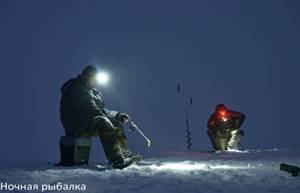
The activity of the fish depends on the density of the school. If the flock is numerous, then it constantly moves around the reservoir. The bite may decrease and then increase again.
Catching smelt in winter
From December to March, in almost every code (there are exceptions when smelt is not caught), smelt is successfully caught on the Volga River near the city of Dubna. Local fishermen call this place “Appendicitis”. This is part of the old bed of the Volga River, which remained as a result of the creation of the Ivankovo Reservoir. (Moscow Sea).
There is no need to look for this fish; it is present throughout the bay evenly. Therefore, observing the fishing ethics of not getting closer than 5-8 meters to the fishermen, you can drill holes not far from these fishermen and immediately start catching smelt.
Tackle
Since this fish does not reach large sizes, the gear for catching it should not be heavy. As a fishing rod, a fishing rod made of foam plastic with a reel would be a good option. Line with a diameter of 0.12 mm.
Let's talk in more detail about choosing a jig. Here you can use various jigs, since smelt is a very voracious fish, and when it starts to bite, you can even catch it with a hook or jigs, which differ from each other in configuration and size.
- Usually a jig is used in the form of a shot, weighing up to 1.3 grams. In cloudy weather, a yellow jig is best suited, and when the bright sun is shining - black. The use of jigs that accumulate light also shows good results. They are also popularly called “phosphorus”.
- Sometimes this fish bites very small sizes. In this case, it is worth using small jigs weighing up to 0.5 grams. This condition must be strictly fulfilled, due to the fact that its mouth is very small, and if the jig is too large in size, then there will be a lot of idle bites.
- The nod should be chosen to be very sensitive. To do this, you can use nods made from plastic bottles up to 130 mm long. Also, nods can be made of metal plates. They are also very useful when fishing for smelt.
Bait
As mentioned above, this energetic fish can be very gluttonous. Therefore, with intense biting, the bait does not play an important role in its capture. But when the bite is not particularly good, then it can best peck on bloodworms and maggots.
Very important advice: you need to catch this fish only with fresh bait. Therefore, bloodworms that have been lying in your refrigerator for more than one day can simply scare away the fish, and they will not bite at all. This has been confirmed in practice more than once.
Fishing for bloodworms, which are first rolled in wheat flour before attaching a jig to the hook, shows good results. This phenomenon is explained by the fact that when a bloodworm falls into the water, a small cloudy cloud forms around it, which attracts our fish. But this does not always happen.
Fishing process
An important component of all fishing trips is the proper arrangement of the fishing spot. If you neglect this, then troubles during fishing will haunt you constantly. For example, if you do not remove the ice chips that form as a result of drilling holes in time, it will freeze, and you will be guaranteed to catch the line and even break it.
- It is very important here to position the bait correctly so that it can be conveniently placed on the hook. To do this, it is necessary to sew an internal pocket in the trigger, where you could put away a box of bloodworms or maggots, hiding it from the frost.
- You must have a 2-liter thermos with hot tea, which is necessary to warm the body. No matter how you dress for winter fishing, you will still freeze. And if you drink a glass of hot tea every 40 minutes, this will not harm you.
- A one-person tent for the winter also saves you from the cold. It is relatively inexpensive, lightweight and very easy to use. You can use an ordinary thick candle to heat the air in the tent. It's enough for a whole day of fishing.
- The fishing technique is practically no different from catching all “white” fish: the jig with bait is lowered to the very bottom, and then we fish all water horizons. Wherever a school of smelt is found, we continue fishing.
Source: https://severtexno.ru/lovlya-koryushki-zimoj.html
Description of smelt
The smelt (Osmerus eperlanus) is a widespread small schooling predator of the order Salmonidae. It is of great commercial importance: capelin (subspecies) alone is harvested annually up to four million tons in the world.
Smelt is interesting both as independent prey and as live bait for catching other predators that stay close to the school.

Smelt
Smelt fish contains a lot of useful substances:
- vitamins A, B, D;
- selenium, iodine, fluorine, calcium, phosphorus, sodium, bromine, potassium;
- Omega-3 polyunsaturated fatty acids;
- amino acids methionine, cysteine, threonine and lysine;
- easily digestible proteins.
Smelt has the smell of fresh cucumbers, which is uncharacteristic of fish.
It is included in the diet for diseases of the cardiovascular system. Low-calorie smelt (150 kcal/100 g) helps reduce cholesterol in the blood and the disappearance of plaques on the walls of blood vessels.
Appearance
The largest smelt specimens reach 40 centimeters in length. The fish has a narrow, scaleless body and a toothed mouth with an elongated lower jaw characteristic of all salmonids. The color of the back is greenish-brown, the sides are silver.
The description of smelt is told by Petr de Crilon SonyKpK in his video.
Nutrition
Main food of smelt:
- zooplankton;
- fry of different fish species;
- caviar.
The most intensive feeding of smelt occurs in spring and autumn, in close proximity to the coast. This is where the fish stay most of the year.
Reproduction
Smelt does not like warm water. Spawning begins immediately after the ice melts at a temperature of five degrees Celsius. Sea fish gather in huge schools and rise several kilometers upstream in the rivers. This is actively used by fishermen using nets.
However, not only fishermen follow schools of smelt going to spawn:
- schools of cod;
- seagulls;
- seals;
- and even whales.
Freshwater smelt search for bays and bays. The spawning process in fish is quite noisy, but short-lived - it can last only a few days.
Spawning grounds are located mainly on sandbanks. The fertility of smelt is 1.5-60 thousand eggs.
Caviar:
- bottom;
- sticky;
- light yellow color;
- with a diameter of 0.5-1.2 millimeters.
The fry hatch in an average of two weeks.
During spawning, the body of the fish is covered with small tubercles. Smelt usually spawns once, rarely twice, in its life, after which it dies or returns to its usual habitats.
Winter gear for smelt
My good friend Viktor Mikhailovich Kalinin introduced me to the secrets of this fishing.
The first acquaintance with smelt took place at the end of February on the ice of the Verkhnetulomskoye reservoir, near Murmansk, during our first joint ice fishing trip.
The gear for catching cucumber fish is simple and reliable, it consists of a winter fishing rod with 25-30 m of fishing line with a diameter of 0.2-0.18 mm wound on a reel. The leash is equipped with two jigs with a light accumulator and a hook No. 6-7, a carabiner is attached to the upper end of the leash, a sinker is attached to the lower end, but a lure with a hanging tee No. 14-16 is better.
In addition, it is useful to hang glitter 5-6 cm long and 2-2.5 cm wide between the jigs. Very good glitters are obtained from a plate from a photo glosser. The nod is spring-loaded with a bright red ball at the end. It is very important to balance the tackle correctly: the mass of the lower sinker (spinner) should tilt the nod 90° in relation to the rod whip.
Tackle for smelt
In this case, the nod when biting will straighten if the smelt lifts the bait from the bottom, or lower if it pulls it down. I stick the fishing rod into the snow at an angle of 60-70°. The bait is “branded” – pieces of the smelt itself, which are used to catch not only this fish, but also burbot. Therefore, an indispensable attribute of the “smelt catcher” is a board and a sharp knife for preparing the bait.
- Having gone out onto the ice, we drilled a number of holes, set up our fishing rods and began to wait for 10 hours: it was at this time that the bite was supposed to begin. Viktor Mikhailovich first baited the worm, and after a few minutes a small burbot was already fluttering on the ice. Its meat is not very suitable for catching smelt, but we had no choice since the worm had run out.
- At about 10 o'clock my partner started biting a few meters from my fishing rods. My nods remained motionless. I was walking with a ladle and cleaning the holes, relaxed a little and did not have time to run up to the fishing rod, on which the nod sharply bent and returned to its original position.
- Kneeling down next to the fishing rod, I watched the nod, almost without breathing. But then he began to slowly swing up and down, and, after waiting for the moment when he went down as far as possible, I sharply hooked him. The next moment, he threw the fishing rod aside and began to select a fishing line, feeling a pleasant weight at its end.
- And here in my hands is a smelt, my first smelt in my life! Crimson gills, a mouth studded with a hundred teeth, a body with a blue tint. You wonder how such a small fish, the size of an average capelin, could take a jig with a piece of fish? But what surprised me most was the specific cucumber smell emanating from this fish.
We spent almost the entire weekend fishing for smelt. My personal record is 74 pieces (about 3 kg). I would like to share the original design of the reel block for leashes. After an unsuccessful experience with cardboard (gets wet, short-lived) and foam plastic (too light, blown away by the wind), I found a design for myself that is durable and has sufficient mass.
Reel for leashes
For ease of transportation, I made a reel to fit the size of a plastic box that came to hand. I take one wall of a plywood box with connecting tenons and saw off a piece of the required length from it. I sand the workpiece and glue on both sides material from a used travel rug.
To fix the leashes in the direction of the rug opposite to the spikes, I pin nail pins opposite the spaces between the spikes. Winding the leash should start from the upper end, putting the carabiner on the head of the pin, and then stick the hooks into the mat. Plywood spikes will prevent the leashes from getting tangled with each other.
Source: https://fishcom67.ru/zimnya-ribalka/snasti-na-koryushku
Techniques and tactics for catching winter smelt on a float
No special training is required to fish in winter. If the inhabitants of reservoirs are active, one fishing rod is enough. You can increase your catch with two attachments.
Catching fish is easy. First, the fisherman finds a place, then he uses an ice drill to make holes. Crushed ice is removed from them using a scoop. No bait is needed, so you can catch fish right away.
The bait is lowered into the hole so that the float is slightly submerged. The fishing rod is secured and a bite is expected. When this happens, the float floats up. At this point the fisherman can hook.

